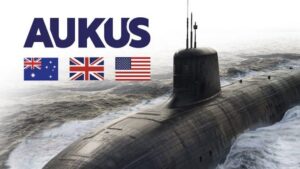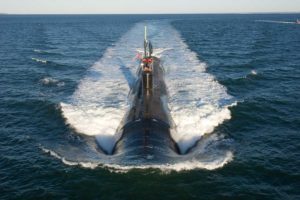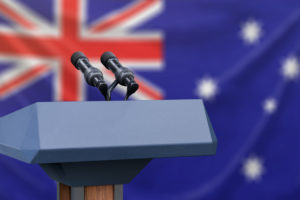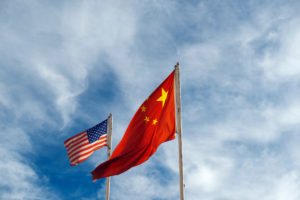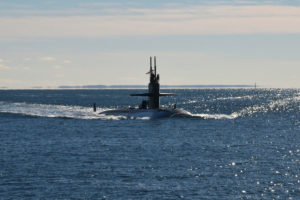Introduction
On 15 September 2021, the governments of Australia, the United States, and the United Kingdom announced the formation of AUKUS – a new security pact designed to “deepen diplomatic, security, and defence cooperation in the Indo-Pacific region”. Although the agreement includes cooperation across a range of advanced capabilities such as hypersonics and quantum technologies, the commitment to provide Australia with at least eight nuclear-propelled, conventionally-armed submarines has become the defining feature of the partnership.
However, the delivery of these submarines will pose considerable challenges. Many commentators have pointed to the risk of alienating other states through the recalibration of international security ties, already demonstrated in spectacular fashion by the diplomatic fall-out with France when Australia reneged on a diesel-powered submarines deal. Others have asked questions about the potential for nuclear proliferation in the Indo-Pacific, with the submarines expected to be fuelled by highly enriched uranium (HEU).
Yet the hardest hurdles to overcome may be far less esoteric. They centre on the nuts and bolts of the submarine building itself, with all three partner countries facing very real constraints on the human, engineering and technological capacity required. More will be known in March 2023 when Australia’s AUKUS submarine taskforce is expected to deliver its recommendations on shipbuilding location, design and workforce needs; but even then, the anticipated gaps in capacity building will be difficult to reconcile. Ahead of the March announcement, this essay seeks to evaluate the key capacity-related construction challenges and provide insights on how this will impact the delivery aspect of AUKUS.
Current Shipbuilding Capacity
Perhaps the most pressing question facing AUKUS right now is where to build the submarines. In the long term, Australia is expected to have its own sovereign shipbuilding capacity with Scott Morrison, Australia’s then prime minister, using the September 2021 launch to declare his administration’s intent to “build these submarines in Adelaide, Australia”. In April 2022 the Australian government published a Factsheet that noted how the country had taken “initial steps to secure additional land on which to build the Nuclear-Powered Submarine Construction Yard, including land adjacent to the existing Osborne North Shipyard”. In preparation for the AUKUS pipeline, Osborne is set to be expanded to more than triple its size.
However, in the short term, Australia faces acute strategic pressures which call for an acceleration of programme delivery. Most obvious is that Australia’s existing fleet of six Collins-class diesel-electric submarines are ageing, with the need to acquire additional submarines first articulated in Australia’s 2009 Defence White Paper. At the time, Australia envisioned procuring 12 conventionally-propelled submarines, designed to “have greater range, longer endurance on patrol, and expanded capabilities” and be able to undertake “certain strategic missions”. But with an impending capability gap it was decided that, in parallel, the Collins class would be given a life-of-type extension (LOTE), prolonging their lifespan by seven years; in 2021, the LOTE was raised to 10 years – meaning that the first boat will retire in 2038. The pressure to expedite naval capabilities led to Australia awarding France a multi-billion contract in 2016 to acquire conventionally-propelled Attack-class submarines, though in 2021 Canberra abruptly scuppered the deal in favour of working within the AUKUS framework.
Although Australia has always prioritised its naval power, growing alarm about China’s perceived territorial ambitions and unrelenting programme of military modernisation has shaped this fast evolving military calculus. Australia is now expected to forge ahead with plans to procure at least eight nuclear-propelled, conventionally-armed submarines by collaborating with its AUKUS partners. However, production will not be simple. Because nuclear propulsion is primarily a military technology with few commercial uses, there are few shipyards across the world capable of designing and building such vessels.
In the US, only two shipyards are fitted and licensed to construct nuclear-propelled craft-namely the General Dynamics Electric Boat’s shipyard in Groton, Connecticut and the Huntington Ingalls Industries’ Newport News Shipbuilding (NNS) shipyard in Virginia. In the UK, expertise is concentrated at the BAE shipyard in Barrow. Moreover, both the US and UK require all military vessels to be built in-country to protect sensitive technologies and intellectual property, as well as maintain a skilled workforce. This means that the AUKUS partners are unlikely to adopt commercial solutions such as subcontracting to overcome capacity constraints.
Current Delivery Constraints
In his September 2021 address, the then British prime minister Boris Johnson highlighted the economic benefits of AUKUS, drawing attention to how the agreement would create “hundreds of highly skilled jobs across the United Kingdom, including in [economically disadvantaged areas such as] Scotland, the north of England, and the Midlands”. With forecasts of between US$70 and US$171 billion for eight boats, AUKUS promises major economic rewards for local shipyards and their suppliers. However, both the US and UK are undergoing their own submarine modernisation efforts that pre-date AUKUS and which will tie up existing capacity for some time. As a result, there are concerns about the American and British shipyards having sufficient capacity to deliver new boats in a timely manner, as well as about the impact of new production on domestic shipbuilding programmes.
US modernisation plans involve the production of several nuclear-propelled next-generation vessels, including: up to 12 Columbia-class SSBNs (which will form the basis of the naval leg of the US nuclear triad); up to 66 Virginia-class SSNs (first commissioned in 2004, and with an expected service life until the 2060s); the SSN(X) ‘next generation’ attack submarine (which will succeed the Virginia class); and up to 10 Gerald R. Ford-class nuclear-powered aircraft carriers. Although not all of these vessels are yet on order , the US has little spare shipbuilding capacity and, as noted by the US Navy’s April 2022 Report to Congress, both shipyards will be “at capacity for the next 15 years”. Indeed, the US Navy is already facing concerns about its own operational gaps which it hopes to reconcile by reducing the build time for the Columbia-class SSBNs. Similarly, the UK is modernising its own submarine fleet, building Astute-class SSNs and Dreadnought-class SSBNs. Although scheduled for completion by the end of 2026, the Astute class has been beset by considerable delays that will likely impact the delivery of the Dreadnought class, the first of which is slated to be introduced from the “2030s onwards”.
With immediate construction unlikely, there have been domestic calls for the Australian Navy to acquire a stop-gap capability, such as surplus US Navy Virginia-class submarines, or UK Navy Astute-class submarines. However, neither of these solutions seem likely with the UK clearly stating that provision of the Astute class is not an option, while suggestions from opposition leader Peter Dutton that Australia could purchase Virginia-class submarines have been dismissed on the basis the US would not accept a shortfall of two submarines by 2030. Instead, it appears that the LOTE programme for the Collins class will bridge the capability gap , although this assumes the next fleet will be delivered on time. Home-porting Virginia-class submarines in Perth is an additional tool that the Australian navy could employ to relieve immediate pressures before it begins to receive its own submarines.
Implications of Submarine Design
There is also considerable uncertainty over the design of the future submarines and the reactor that will power them. As noted, both the UK and the US are already preparing for their own next generation submarine programmes, and one option may be to supply Australia with one such design, or invite Australian cooperation on these existing projects. Indeed, it is notable that the UK chose to announce the award of design work on the Astute’s replacement programme (known as SSN(R)) on 17 September 2021, just two days after the AUKUS announcement; and that Australian crews have already begun to train on the Astute class.
Cooperation under AUKUS also raises the possibility of the three navies working together on a common SSN design. The opportunity to upgrade future capabilities is an obvious win for all three AUKUS partners, while military interoperability and economies of scale will no doubt be a factor in the cost-benefit analysis. Such a move would also enable Australia to be better incorporated into the programme, with one possible option involving Adelaide’s Osborne Shipyard building sections of the hull for all three navies.
However, no option is without risk, with Dutton advising caution with a first-in-class design, which could be “problematic in any ship build because time and cost blowouts and design faults are inevitable”. Such risks will only be amplified should Australia opt to develop an indigenous next-generation design. Before the March 2023 AUKUS announcement, the Australian government is expected to release the findings of a defence strategic review, which will set out how military spending will be prioritised in the coming decades. But whatever design option is chosen, it is likely to be at least the 2040s before the boats hit the water.
There are also hard choices to be made regarding the choice of reactor. Australia lacks an experienced nuclear industry capable of designing and building its own nuclear reactors, or the capacity to enrich and build its own fuel. As such, Australia will be reliant on an American or British built reactor. However, inclusion of nuclear technology is proving controversial. To overcome such opposition, it may be politically expedient to use a reactor that operates on low enriched uranium (LEU) fuel. This would help to both dispel proliferation fears and deny potential proliferants the opportunity to cite AUKUS in justifying nuclear modernisation or proliferation, as Iran has previously tried. Of the world’s six states that employ nuclear-propulsion, China and France use LEU-fuelled systems while India and Russia use medium enrichment ones; all four states operate in the Indo-Pacific, under varying mission parameters. However, Australia has all but ruled out the LEU option due to the technical complexities of refuelling the submarines every 10 years.
Such decisions could have real knock-on effects, including where and how the AUKUS submarines will be built. Early indications point to a US reactor design as a preferred option. Should this be the case, the US would take ownership of the programme’s nuclear propulsion aspects, and therefore would be likely to take leadership over the wider programme, with a risk of pushing up costs. One option put forward in the Australian Senate is for the front half to be built in Australia, with the rear half – containing the reactor – to be built overseas. Undoubtedly the most complex aspect would be marrying the two parts, which would likely to be done in the US to avoid transporting the reactor overseas for integration.
In January 2023, Australia’s Defence Minister and Deputy Prime Minister Richard Marles hinted that production may need to begin abroad until Australian production capacity can ramp up. Such a move would help expedite the shipbuilding process – and allay concerns about Australia’s capability gap – but it will be a blow to Adelaide’s shipbuilding industry. There will also be tough questions from the Australian public with taxpayers’ money effectively subsidising US military production lines. A broader issue here for all three partner governments will be how to maintain domestic support for AUKUS where such huge capital outlays are required but the promised strategic benefits may not be quite so tangible to their publics.
The eyewatering costs involved also raise another question about opportunity costs. While the SSNs promise important tactical advantages to the Australian Navy, the alternative option of building additional numbers of Collins-class boats offer the advantage of quantity, a not insignificant benefit when operating in such a broad expanse as the Indo-Pacific. Taking this option would also allow for accelerated delivery and minimise the risks of a three-way design pathway. It would also enable Australian dollars to remain at home in a boost for the domestic industrial base.
Challenges over Workforce Capacity
A less debated but nonetheless very real obstacle for submarine delivery is insufficient workforce capacity in all three AUKUS countries. An Australian government study released in September 2022 highlighted that “owning and operating nuclear-powered submarines will require substantial development of Australia’s workforce”. Although all three countries have world-class shipbuilding capabilities, domestic shipyard industries typically succumb to cyclical business pressures, with rapid upswings followed by deep decline. This is further compounded by the dwindling numbers of skilled craft workers entering the profession amid an ageing workforce, while national security requirements complicate employers recruiting from abroad.
The US Congressional Budget Office released a report in March 2021 that highlighted significant delays in US shipyards in completing maintenance on US Navy submarines. It noted that the US Navy has not hired sufficient numbers of new workers to keep pace of current workload, and forecast a maintenance shortfall in the next two to three decades. With all the US Navy’s submarines being nuclear-propelled, maintenance weaknesses raise serious questions for naval operations as well as broader national security. Whether the pathway to submarines delivery under AUKUS harnesses a mature submarine design or collaborates over a new one, all three governments will need to dedicate significant resources to growing the workforce in line with future demand.
Another aspect of workforce capacity is the military personnel who will operate and maintain the submarines. With decades of experience behind them, the US and UK have pipelines of personnel skilled in operating nuclear-propulsion submarines, but this is not the case for Australia. Recognising this, the US and Australia in June 2022 signed the ‘Australia-US Submarine Officer Pipeline Act’ which will enable an exchange programme between the US Navy and Royal Australian Navy to integrate and train the future Australian mariners. While this is a pragmatic step, transitioning from the Collins-class to an entirely new class of submarine will require a whole cadre of trained staff, not least those specialised in nuclear technology. The other AUKUS partners also stand to benefit from collaborating in workforce capacity building, such as by deepening their own technical expertise and participating in the exchange of personnel and information.
Building in Sustainability
Once built, Australia will also face significant questions over the support and maintenance of its new submarine fleet. Known in the UK as long overhaul periods (LOPs), the deep maintenance and refitting of submarines are major engineering tasks: each Vanguard-class SSBN LOP typically lasts three-and-a-half-years with an additional 18 months of planning before a boat enters the dry dock. It is notable that both the UK and US have experienced significant delays with their own various refit programmes. In the UK, HMS Vanguard began its second LOP at the Devonport Royal Dockyard in December 2015 with an expectation of returning to sea in early 2020. However, after microscopic cracks were detected in fuel rods similar to those used on Vanguard, the UK’s Ministry of Defence ordered that Vanguard’s reactor fuel be replaced, adding considerable time and costs to the LOP.
In the US, the Government Accountability Office (GAO) released a report in 2019 that found the US Navy “was unable to complete scheduled ship maintenance on time for about 75 percent of the maintenance periods conducted during fiscal years 2014 through 2019, with more than half of the delays in fiscal year 2019 exceeding 90 days”. According to the GAO, multiple factors contributed to these maintenance delays, including “insufficient shipyard capacity, shortage of skilled personnel, and deferred maintenance during operational deployments, among others”. Nor are such delays cheap. In addition to reducing assets available for operations and training, the GAO estimated that between FY2008-2018 the USN spent more than US$1.5 billion in support costs due to delayed maintenance for its attack submarines.
Although Australia has exiting dry-docks for its Collins-class submarines, these are neither nuclear certified nor seemingly prepared for the scale of future boats, regardless of the final design chosen. A 2022 report by the Australian Strategic Policy Institute (ASPI) found that a deep-maintenance activity on a Virginia-class submarine would be “nearly three times as much effort as a Collins full-cycle docking”. It also found that “the sustainment of a fleet of eight SSNs would likely involve more work than the build of the [original French-designed] Attack class and the sustainment of the Collins class combined”. As such, the maintenance of any future first-in-class fleet is likely to present even more challenges than the immediate issues around designing and building it. Given the Australian government’s finite resources, the ASPI report arguesthat Australia should consider the implications of AUKUS on sovereign industrial capabilities, stating, “sovereignty rests in our ability to sustain the boats, so that should be the priority”. New facilities may also have strategic value for the partnership, particularly given the paucity of submarine-ready dry docks in the region – a fact highlighted after USS Connecticut ran into an undersea feature in 2021.
Conclusion
AUKUS is a unique and historical partnership, stemming from mutual strategic interests in the Indo-Pacific and the need of all three partners to upgrade their submarine capabilities, a hugely significant military upgrade that has happened to coincide at almost the same time. However, AUKUS faces significant challenges over almost all aspects of submarine delivery, from designing and building the submarines, to their crewing and maintenance. With such acute obstacles, it cannot be taken for granted that the AUKUS framework will eventually deliver Australia’s submarines – and progress may ultimately pivot on advanced capabilities, the second pillar of AUKUS, or other forms of collaboration.
Overcoming these challenges will require innovative and costly solutions. Notwithstanding, the potential for a shared design and increased technological collaboration between the three partners is attractive in light of financial constraints and the steps towards military burden sharing will have additional positive impacts for other countries in the nexus of the US liberal order. Given the high barriers to progress, if cooperation under AUKUS proves to be a success, the momentum might be harnessed to advance broader areas of mutual interest in the Indo-Pacific, such as economic development for the region’s poorer countries and combatting the existential threat of climate change. Regardless of future promise, much will depend on the finances, practicalities and logistics of programme delivery, with the March 2023 announcement eagerly awaited.
Essay submitted: 25 January 2023
